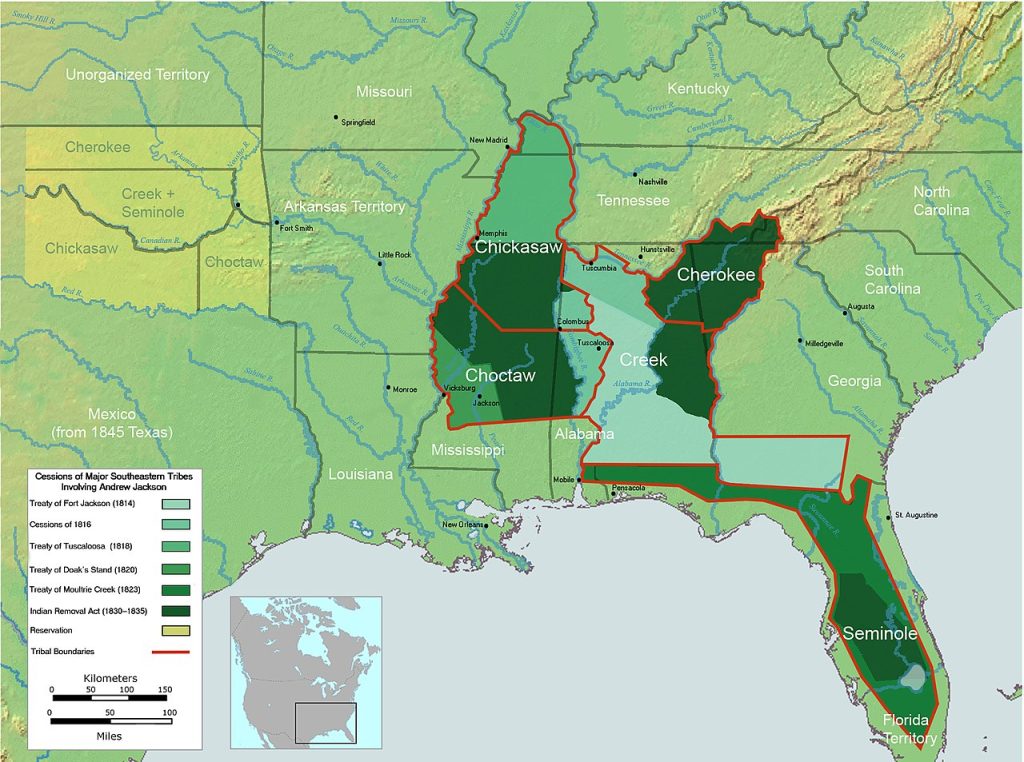WEEK 26
Indian Removal Act of 1830
The Indian Removal Act and treaties involving Jackson before his presidency displaced most of the major tribes of the Southeast from their traditional territories east of the Mississippi River. Jackson's presidency marked the beginning of a national policy of Native American removal. Before Jackson took office, the relationship between the southern states and the Native American tribes who lived within their boundaries was strained. The states felt that they had full jurisdiction over their territories; the native tribes saw themselves as autonomous nations that had a right to the land they lived on. Significant portions of the five major tribes in the area then known as the Southwest—the Cherokee, Choctaw, Chickasaw, Creek, and Seminoles— began to adopt white culture, including education, agricultural techniques, a road system, and rudimentary manufacturing. In the case of the tensions between the state of Georgia and the Cherokee, Adams had tried to address the issue encouraging Cherokee emigration west of the Mississippi through financial incentives, but most refused.
In the first days of Jackson's presidency, some southern states passed legislation extending state jurisdiction to Native American lands. Jackson supported the states' right to do so. His position was later made clear in the 1832 Supreme Court test case of this legislation, Worcester v. Georgia. Georgia had arrested a group of missionaries for entering Cherokee territory without a permit; the Cherokee declared these arrests illegal. The court under Chief Justice John Marshall decided in favor of the Cherokee: imposition of Georgia law on the Cherokee was unconstitutional. Horace Greeley alleges that when Jackson heard the ruling, he said, "Well, John Marshall has made his decision, but now let him enforce it." Although the quote may be apocryphal, Jackson made it clear he would not use the federal government to enforce the ruling. Jackson used the power of the federal government to enforce the separation of Indigenous tribes and whites. In May 1830, Jackson signed the Indian Removal Act, which Congress had narrowly passed. It gave the president the right to negotiate treaties to buy tribal lands in the eastern part of the United States in exchange for lands set aside for Native Americans west of the Mississippi, as well as broad discretion on how to use the federal funds allocated to the negotiations. The law was supposed to be a voluntary relocation program, but it was not implemented as one. Jackson's administration often achieved agreement to relocate through bribes, fraud and intimidation, and the leaders who signed the treaties often did not represent the entire tribe. The relocations could be a source of misery too: the Choctaw relocation was rife with corruption, theft, and mismanagement that brought great suffering to that people. In 1830, Jackson personally negotiated with the Chickasaw, who quickly agreed to move. In the same year, Choctaw leaders signed the Treaty of Dancing Rabbit Creek; the majority did not want the treaty but complied with its terms. In 1832, Seminole leaders signed the Treaty of Payne's Landing, which stipulated that the Seminoles would move west and become part of the Muscogee Creek Confederacy if they found the new land suitable. Most Seminoles refused to move, leading to the Second Seminole War in 1835 that lasted six years. Members of the Muscogee Creek Confederacy ceded their land to the state of Alabama in the Treaty of Cusseta of 1832. Their private ownership of the land was to be protected, but the federal government did not enforce this. The government did encourage voluntary removal until the Creek War of 1836, after which almost all Creek were removed to Oklahoma territory. In 1836, Cherokee leaders ceded their land to the government by the Treaty of New Echota. Their removal, known as the Trail of Tears, was enforced by Jackson's successor, Van Buren. Jackson also applied the removal policy in the Northwest. He was not successful in removing the Iroquois Confederacy in New York, but when some members of the Meskwaki (Fox) and the Sauk triggered the Black Hawk War by trying to cross back to the east side of the Mississippi, the peace treaties ratified after their defeat reduced their lands further. During his administration, he made about 70 treaties with American Indian tribes. He had removed almost all the Native Americans east of the Mississippi and south of Lake Michigan, about 70,000 people, from the United States; though it was done at the cost of thousands of Native American lives lost because of the unsanitary conditions and epidemics arising from their dislocation, as well as their resistance to expulsion. Jackson's implementation of the Indian Removal Act contributed to his popularity with his constituency. He added over 170,000 square miles of land to the public domain, which primarily benefited the United States' agricultural interests. The act also benefited small farmers, as Jackson allowed them to purchase moderate plots at low prices and offered squatters on land formerly belonging to Native Americans the option to purchase it before it was offered for sale to others.

